Page 48 of 104
Relay module
The relay box is located by the power distribution box in front of the
radiator in the engine compartment.
The relays are coded as follows:
Relay location Description
1 Back up Lamp
2 Running Lamp
3 Not Used
4 Headlamp DRL
CHANGING THE TIRES
If you get a flat tire while driving, do not apply the brake heavily.
Instead, gradually decrease your speed. Hold the steering wheel firmly
and slowly move to a safe place on the side of the road.
12 43
Roadside emergencies
48
Page 58 of 104
Do not start your engine with the air cleaner removed and do
not remove it while the engine is running.
IDENTIFYING COMPONENTS IN THE ENGINE COMPARTMENT
6.8L V10 ENGINE
1. Engine coolant reservoir
2. Engine oil filler cap
3. Automatic transmission fluid dipstick
4. Power distribution box
5. Engine oil dipstick
6. Air filter assembly
7. Brake fluid reservoir
8. Power steering fluid reservoir
1254367
8
Maintenance and care
58
Page 68 of 104
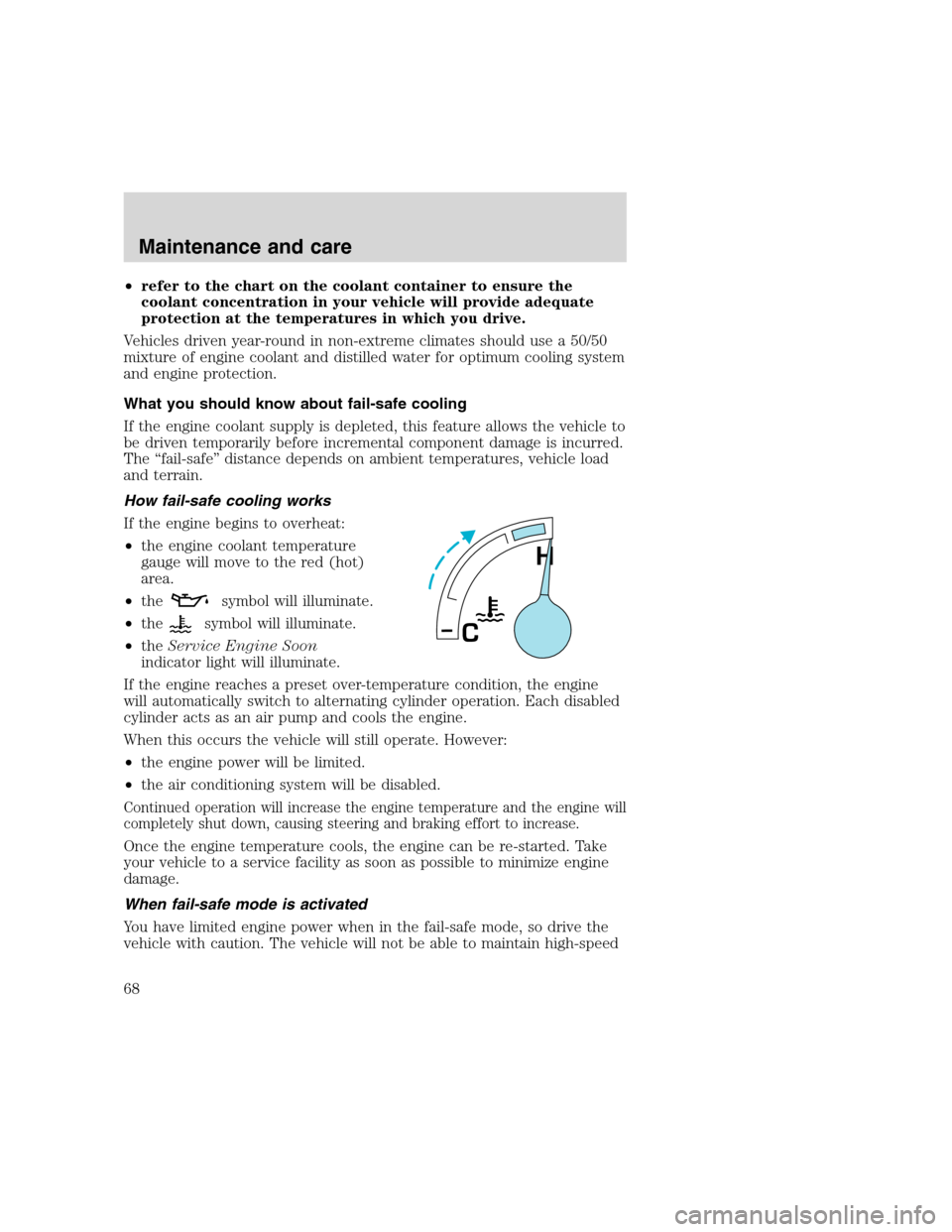
•refer to the chart on the coolant container to ensure the
coolant concentration in your vehicle will provide adequate
protection at the temperatures in which you drive.
Vehicles driven year-round in non-extreme climates should use a 50/50
mixture of engine coolant and distilled water for optimum cooling system
and engine protection.
What you should know about fail-safe cooling
If the engine coolant supply is depleted, this feature allows the vehicle to
be driven temporarily before incremental component damage is incurred.
The “fail-safe” distance depends on ambient temperatures, vehicle load
and terrain.
How fail-safe cooling works
If the engine begins to overheat:
•the engine coolant temperature
gauge will move to the red (hot)
area.
•the
symbol will illuminate.
•the
symbol will illuminate.
•theService Engine Soon
indicator light will illuminate.
If the engine reaches a preset over-temperature condition, the engine
will automatically switch to alternating cylinder operation. Each disabled
cylinder acts as an air pump and cools the engine.
When this occurs the vehicle will still operate. However:
•the engine power will be limited.
•the air conditioning system will be disabled.
Continued operation will increase the engine temperature and the engine will
completely shut down, causing steering and braking effort to increase.
Once the engine temperature cools, the engine can be re-started. Take
your vehicle to a service facility as soon as possible to minimize engine
damage.
When fail-safe mode is activated
You have limited engine power when in the fail-safe mode, so drive the
vehicle with caution. The vehicle will not be able to maintain high-speed
H
C
Maintenance and care
68
Page 69 of 104
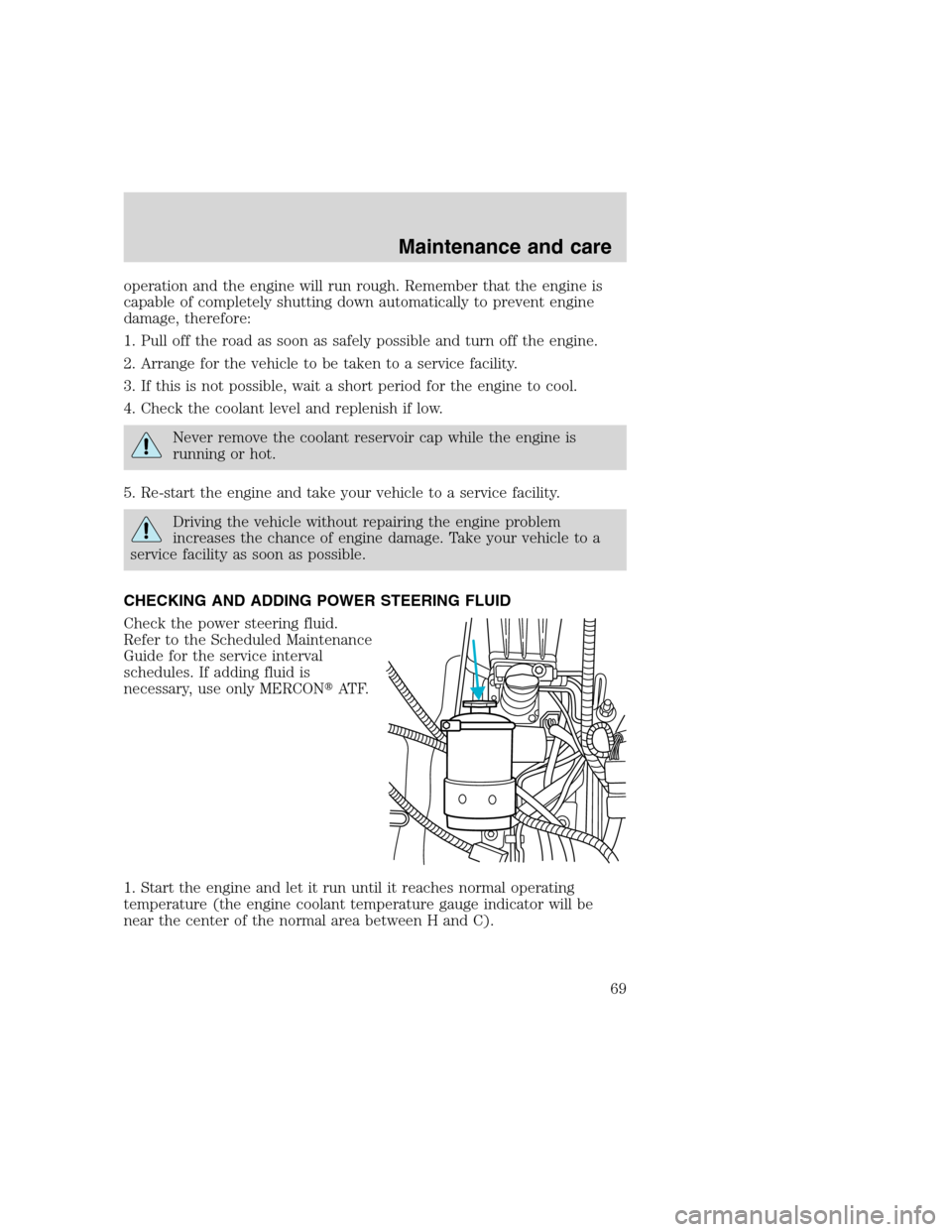
operation and the engine will run rough. Remember that the engine is
capable of completely shutting down automatically to prevent engine
damage, therefore:
1. Pull off the road as soon as safely possible and turn off the engine.
2. Arrange for the vehicle to be taken to a service facility.
3. If this is not possible, wait a short period for the engine to cool.
4. Check the coolant level and replenish if low.
Never remove the coolant reservoir cap while the engine is
running or hot.
5. Re-start the engine and take your vehicle to a service facility.
Driving the vehicle without repairing the engine problem
increases the chance of engine damage. Take your vehicle to a
service facility as soon as possible.
CHECKING AND ADDING POWER STEERING FLUID
Check the power steering fluid.
Refer to the Scheduled Maintenance
Guide for the service interval
schedules. If adding fluid is
necessary, use only MERCON�AT F.
1. Start the engine and let it run until it reaches normal operating
temperature (the engine coolant temperature gauge indicator will be
near the center of the normal area between H and C).
Maintenance and care
69
Page 70 of 104
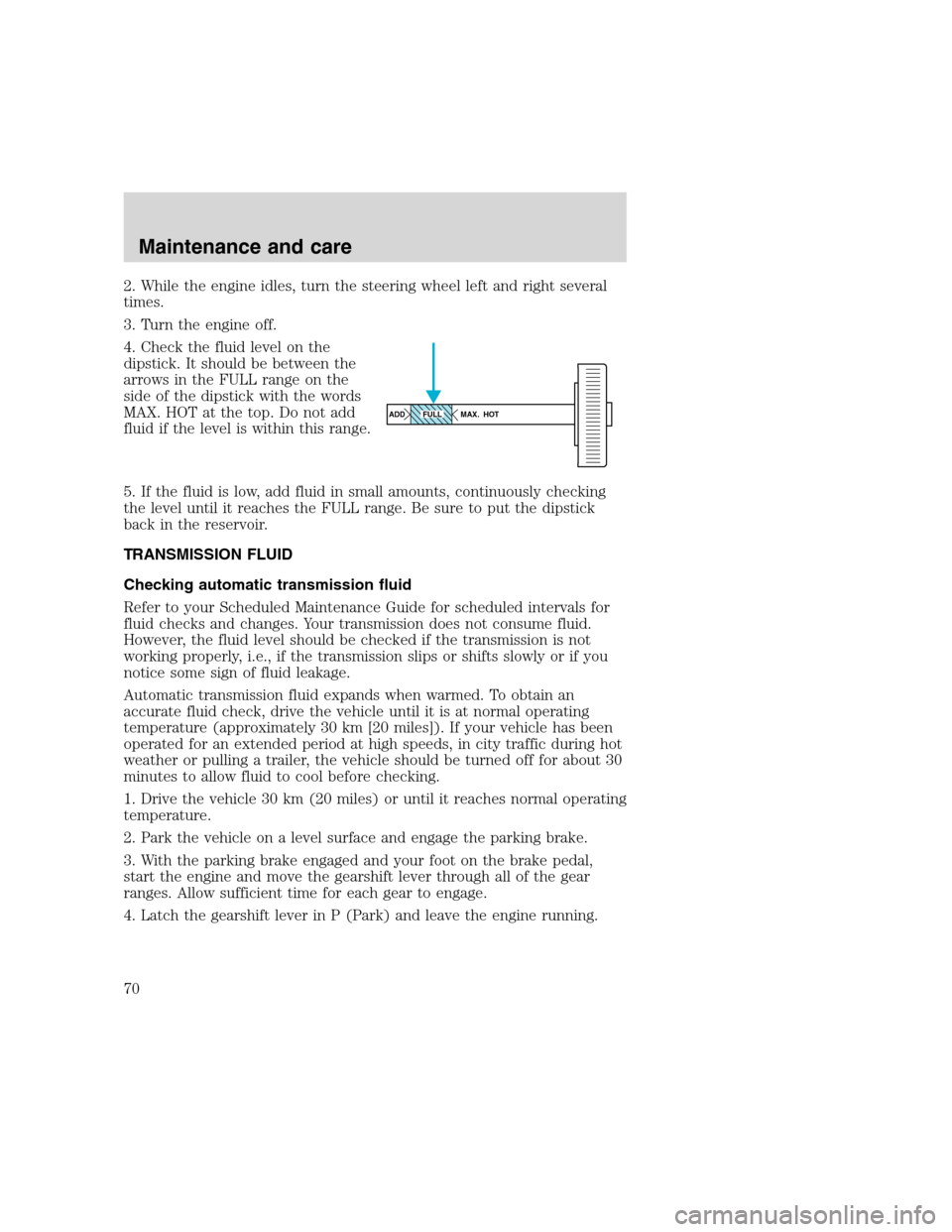
2. While the engine idles, turn the steering wheel left and right several
times.
3. Turn the engine off.
4. Check the fluid level on the
dipstick. It should be between the
arrows in the FULL range on the
side of the dipstick with the words
MAX. HOT at the top. Do not add
fluid if the level is within this range.
5. If the fluid is low, add fluid in small amounts, continuously checking
the level until it reaches the FULL range. Be sure to put the dipstick
back in the reservoir.
TRANSMISSION FLUID
Checking automatic transmission fluid
Refer to your Scheduled Maintenance Guide for scheduled intervals for
fluid checks and changes. Your transmission does not consume fluid.
However, the fluid level should be checked if the transmission is not
working properly, i.e., if the transmission slips or shifts slowly or if you
notice some sign of fluid leakage.
Automatic transmission fluid expands when warmed. To obtain an
accurate fluid check, drive the vehicle until it is at normal operating
temperature (approximately 30 km [20 miles]). If your vehicle has been
operated for an extended period at high speeds, in city traffic during hot
weather or pulling a trailer, the vehicle should be turned off for about 30
minutes to allow fluid to cool before checking.
1. Drive the vehicle 30 km (20 miles) or until it reaches normal operating
temperature.
2. Park the vehicle on a level surface and engage the parking brake.
3. With the parking brake engaged and your foot on the brake pedal,
start the engine and move the gearshift lever through all of the gear
ranges. Allow sufficient time for each gear to engage.
4. Latch the gearshift lever in P (Park) and leave the engine running.
ADD MAX. HOTFULL
Maintenance and care
70
Page 93 of 104
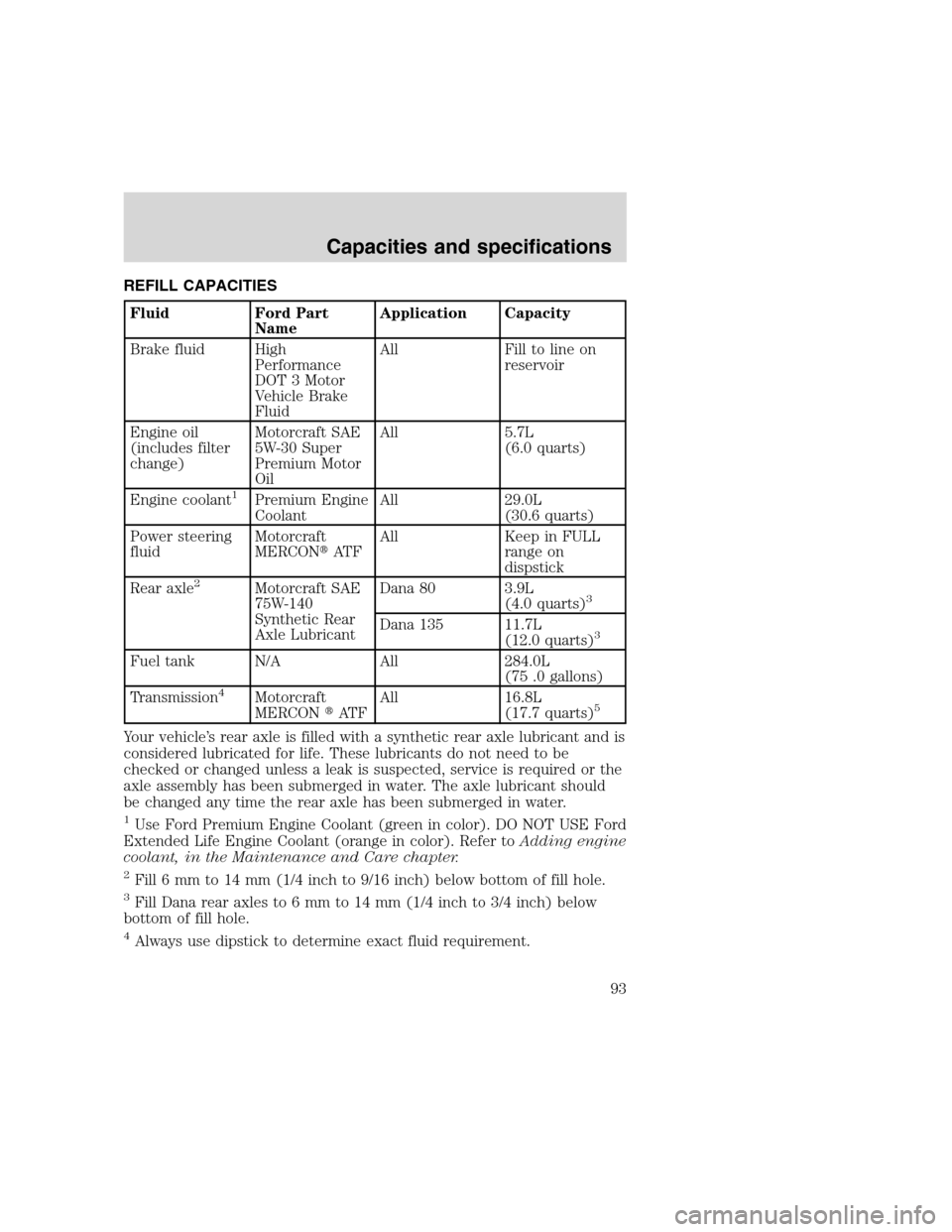
REFILL CAPACITIES
Fluid Ford Part
NameApplication Capacity
Brake fluid High
Performance
DOT 3 Motor
Vehicle Brake
FluidAll Fill to line on
reservoir
Engine oil
(includes filter
change)Motorcraft SAE
5W-30 Super
Premium Motor
OilAll 5.7L
(6.0 quarts)
Engine coolant
1Premium Engine
CoolantAll 29.0L
(30.6 quarts)
Power steering
fluidMotorcraft
MERCON�AT FAll Keep in FULL
range on
dispstick
Rear axle
2Motorcraft SAE
75W-140
Synthetic Rear
Axle LubricantDana 80 3.9L
(4.0 quarts)3
Dana 135 11.7L
(12.0 quarts)3
Fuel tank N/A All 284.0L
(75 .0 gallons)
Transmission
4Motorcraft
MERCON�AT FAll 16.8L
(17.7 quarts)5
Your vehicle’s rear axle is filled with a synthetic rear axle lubricant and is
considered lubricated for life. These lubricants do not need to be
checked or changed unless a leak is suspected, service is required or the
axle assembly has been submerged in water. The axle lubricant should
be changed any time the rear axle has been submerged in water.
1Use Ford Premium Engine Coolant (green in color). DO NOT USE Ford
Extended Life Engine Coolant (orange in color). Refer toAdding engine
coolant, in the Maintenance and Care chapter.
2Fill 6 mm to 14 mm (1/4 inch to 9/16 inch) below bottom of fill hole.
3Fill Dana rear axles to 6 mm to 14 mm (1/4 inch to 3/4 inch) below
bottom of fill hole.
4Always use dipstick to determine exact fluid requirement.
Capacities and specifications
93
Page 94 of 104
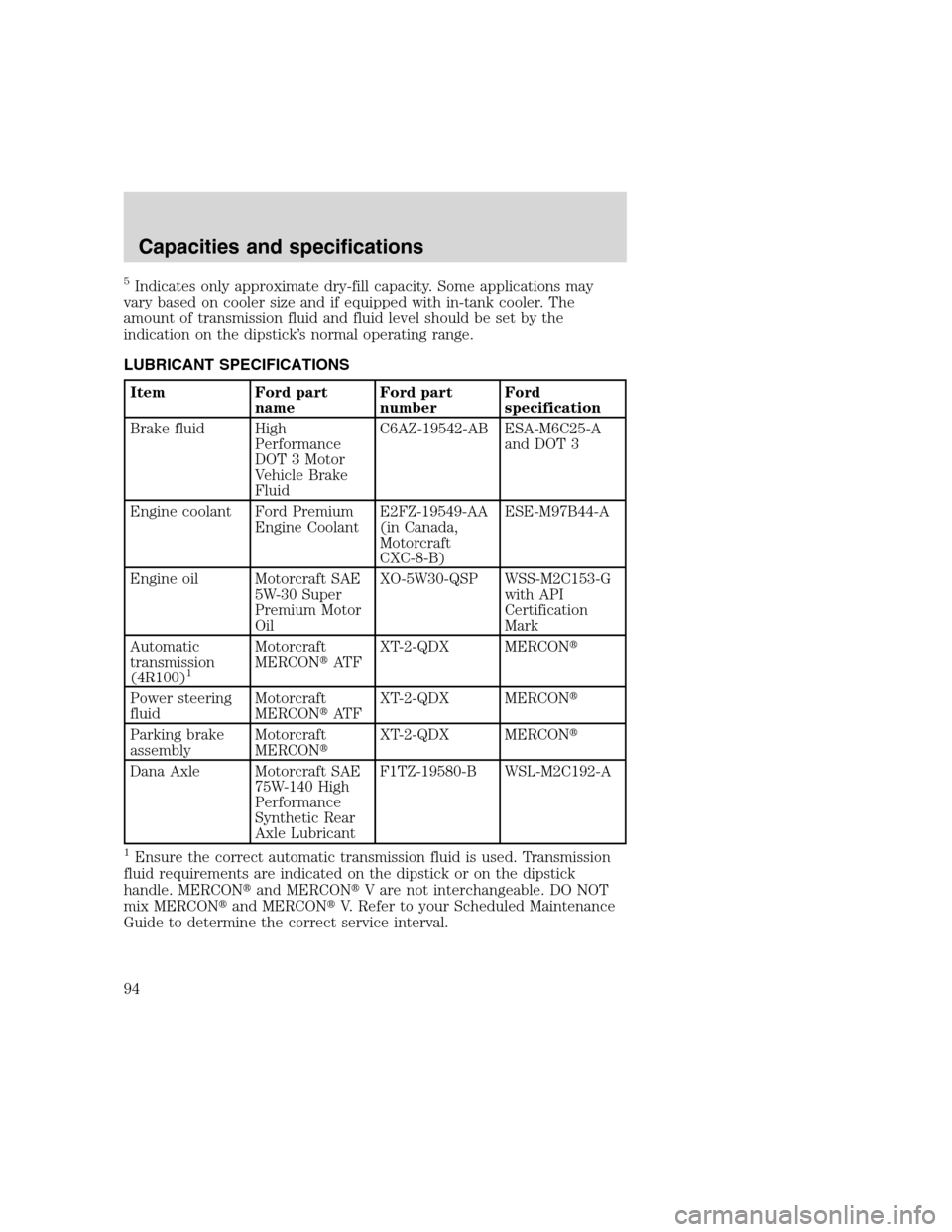
5Indicates only approximate dry-fill capacity. Some applications may
vary based on cooler size and if equipped with in-tank cooler. The
amount of transmission fluid and fluid level should be set by the
indication on the dipstick’s normal operating range.
LUBRICANT SPECIFICATIONS
Item Ford part
nameFord part
numberFord
specification
Brake fluid High
Performance
DOT 3 Motor
Vehicle Brake
FluidC6AZ-19542-AB ESA-M6C25-A
and DOT 3
Engine coolant Ford Premium
Engine CoolantE2FZ-19549-AA
(in Canada,
Motorcraft
CXC-8-B)ESE-M97B44-A
Engine oil Motorcraft SAE
5W-30 Super
Premium Motor
OilXO-5W30-QSP WSS-M2C153-G
with API
Certification
Mark
Automatic
transmission
(4R100)
1
Motorcraft
MERCON�AT FXT-2-QDX MERCON�
Power steering
fluidMotorcraft
MERCON�AT FXT-2-QDX MERCON�
Parking brake
assemblyMotorcraft
MERCON�XT-2-QDX MERCON�
Dana Axle Motorcraft SAE
75W-140 High
Performance
Synthetic Rear
Axle LubricantF1TZ-19580-B WSL-M2C192-A
1Ensure the correct automatic transmission fluid is used. Transmission
fluid requirements are indicated on the dipstick or on the dipstick
handle. MERCON�and MERCON�V are not interchangeable. DO NOT
mix MERCON�and MERCON�V. Refer to your Scheduled Maintenance
Guide to determine the correct service interval.
Capacities and specifications
94
Page 100 of 104
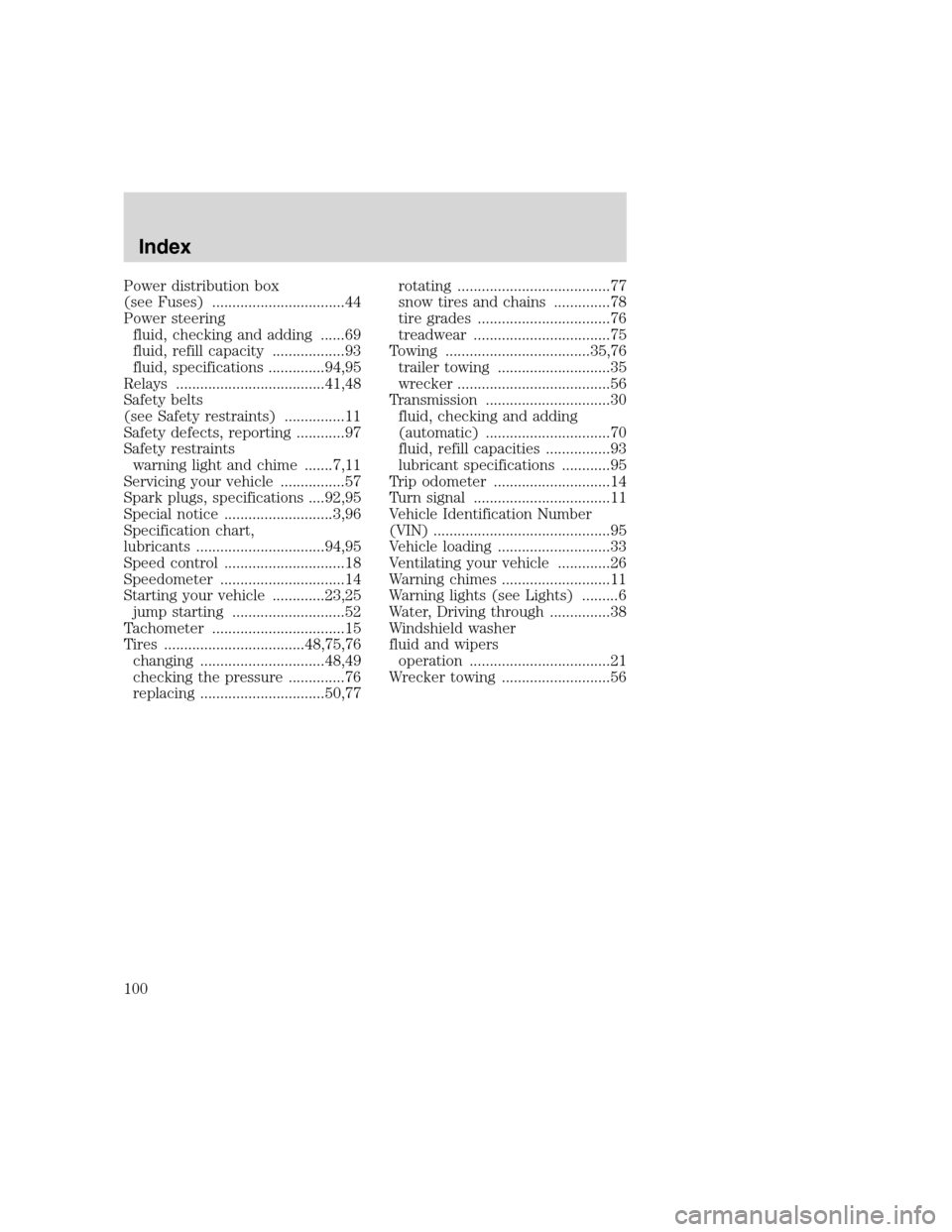
Power distribution box
(see Fuses) .................................44
Power steering
fluid, checking and adding ......69
fluid, refill capacity ..................93
fluid, specifications ..............94,95
Relays .....................................41,48
Safety belts
(see Safety restraints) ...............11
Safety defects, reporting ............97
Safety restraints
warning light and chime .......7,11
Servicing your vehicle ................57
Spark plugs, specifications ....92,95
Special notice ...........................3,96
Specification chart,
lubricants ................................94,95
Speed control ..............................18
Speedometer ...............................14
Starting your vehicle .............23,25
jump starting ............................52
Tachometer .................................15
Tires ...................................48,75,76
changing ...............................48,49
checking the pressure ..............76
replacing ...............................50,77rotating ......................................77
snow tires and chains ..............78
tire grades .................................76
treadwear ..................................75
Towing ....................................35,76
trailer towing ............................35
wrecker ......................................56
Transmission ...............................30
fluid, checking and adding
(automatic) ...............................70
fluid, refill capacities ................93
lubricant specifications ............95
Trip odometer .............................14
Turn signal ..................................11
Vehicle Identification Number
(VIN) ............................................95
Vehicle loading ............................33
Ventilating your vehicle .............26
Warning chimes ...........................11
Warning lights (see Lights) .........6
Water, Driving through ...............38
Windshield washer
fluid and wipers
operation ...................................21
Wrecker towing ...........................56
Index
100